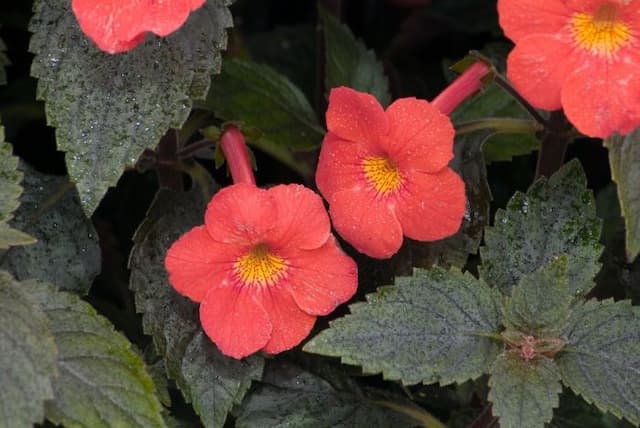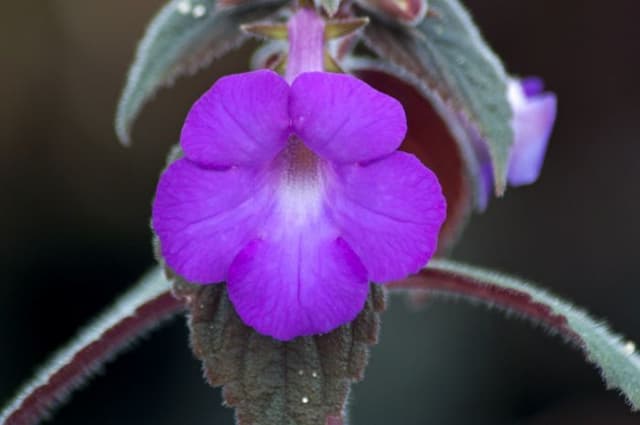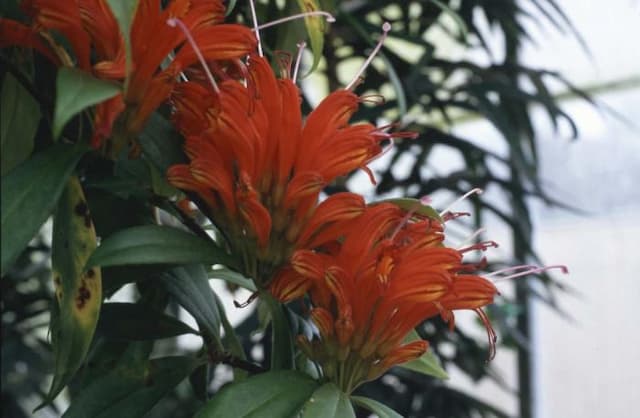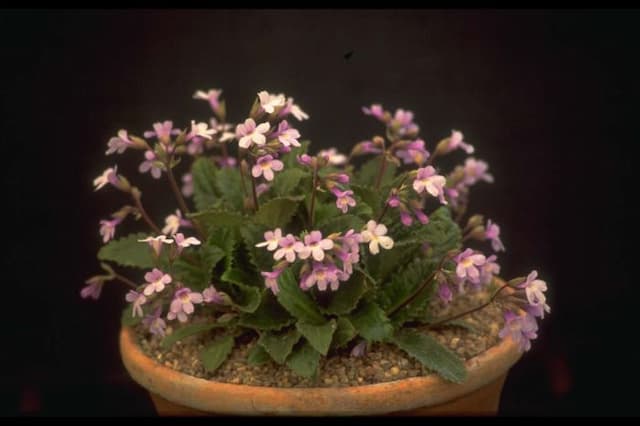Hardy white gloxinia Sinningia tubiflora

ABOUT
Sinningia tubiflora, commonly known as the tube-flowering sinningia or hardy white gloxinia, is a tuberous perennial plant well-loved for its attractive floral display. This plant typically forms a basal rosette of soft, furry, green leaves which are broadly lance-shaped and can have a slightly wavy margin. The leaves can vary in texture and often have a pleasant, velvety touch. Most striking are its flowers, for which it is particularly valued. The blooms are trumpet-shaped and purely white, exuding a sweet fragrance that is especially noticeable in the evening. These tube-like flowers dangle on slender stalks, creating a beautiful contrast against the green foliage. The blooms can be quite long and slender, contributing to the plant's delicate and exotic appearance. The plant's flowering season can add an enchanting display to gardens or indoor spaces, while its underground storage structure—a tuber—enables it to survive periods of dormancy. When in bloom, the white, nocturnally fragrant flowers become the highlight, which can sometimes attract pollinators such as moths.
About this plant
 Names
NamesFamily
Gesneriaceae
Synonyms
Hardy White Gloxinia, White Trumpet Flower
Common names
Sinningia tubiflora.
 Toxicity
ToxicityTo humans
The Sinningia tubiflora, commonly known as Hardy White Gloxinia, is not widely reported as a toxic plant to humans. However, it is generally advisable to be cautious and prevent ingestion of any plant parts if the toxicity is unclear, as the plant may still cause mild gastrointestinal discomfort or other individual reactions in some people. If a person ingests part of the Hardy White Gloxinia and experiences symptoms such as nausea, vomiting, or diarrhea, they should seek medical attention.
To pets
The Hardy White Gloxinia is not specifically listed as toxic to pets, such as cats and dogs. Nonetheless, it is always a good practice to keep houseplants out of reach of pets, especially if their toxicity is not well documented. If a pet ingests part of the plant and exhibits symptoms like gastrointestinal upset, drooling, or changes in behavior, it is important to contact a veterinarian for guidance.
 Characteristics
CharacteristicsLife cycle
Perennials
Foliage type
Deciduous
Color of leaves
Green
Flower color
White
Height
1-2 feet [30-60 cm]
Spread
1-2 feet [30-60 cm]
Plant type
Bulb
Hardiness zones
10
Native area
South America
Benefits
 General Benefits
General Benefits- Aesthetic Appeal: Sinningia tubiflora, commonly known as Hardy White Gloxinia, has attractive tubular white flowers that enhance the visual appeal of gardens and indoor spaces.
- Easy to Grow: This plant is known for being easy to care for, making it suitable for gardeners of all skill levels.
- Drought Tolerance: Hardy White Gloxinia can withstand periods of drought, reducing the need for frequent watering.
- Pollinator Attraction: The flowers can attract hummingbirds and other pollinators, promoting biodiversity in the garden.
- Container Gardening: Sinningia tubiflora is suitable for container gardening, allowing it to be grown in small spaces or urban environments.
- Long Blooming Period: The plant has a long flowering period, offering consistent beauty throughout its blooming season.
- Low Maintenance: Hardy White Gloxinia requires minimal pruning and is relatively disease- and pest-resistant, further reducing the need for intensive care.
 Medical Properties
Medical PropertiesThis plant is not used for medical purposes.
 Air-purifying Qualities
Air-purifying QualitiesThis plant is not specifically known for air purifying qualities.
 Other Uses
Other Uses- Scented Ornamental: The white trumpet flowers of Sinningia tubiflora are highly fragrant, especially in the evening, and can be used to add a pleasant aroma to gardens and patios.
- Night Garden Plant: Because its flowers open at night and are visible in moonlight, Sinningia tubiflora can be used to create a moon garden—a garden designed to be enjoyed in the evening and nighttime.
- Hummingbird Attractant: Although not its main purpose, the shape and size of the flowers of Sinningia tubiflora can occasionally attract hummingbirds, making it suitable for a pollinator garden.
- Photography Subject: Gardeners and photographers may use Sinningia tubiflora as a subject for macro photography due to its intricate flowering structure and the contrast between its flowers and foliage.
- Container Gardening: With its tuberous roots, Sinningia tubiflora can be grown in containers and moved indoors during colder months, making it an excellent choice for those with limited garden space.
- Educational Use: In botanical and horticultural education, Sinningia tubiflora is used to demonstrate tuber formation and care for tuberous plants.
- Horticultural Shows: Due to its unique flowering pattern and attractive blossoms, Sinningia tubiflora can be a showpiece in horticultural exhibitions and shows.
- Landscape Accent Plant: When strategically placed, Sinningia tubiflora can be used as an accent plant to highlight certain areas of a landscape design.
- Theme Gardens: In gardens with a specific theme, such as a white garden or a fragrance garden, Sinningia tubiflora can be included due to its white color and scented flowers.
- Gift Plant: As a less common ornamental plant, Sinningia tubiflora can be offered as a gift to plant enthusiasts looking for something unusual to add to their collections.
Interesting Facts
 Feng Shui
Feng ShuiThe plant Sinningia tubiflora, commonly known as Hardy White Gloxinia, is not used in Feng Shui practice.
 Zodiac Sign Compitability
Zodiac Sign CompitabilityHardy White Gloxinia is not used in astrology practice.
 Plant Symbolism
Plant Symbolism- Resilience - Often found thriving in challenging environments, the Sinningia tubiflora, commonly known as Tube Sinningia, symbolizes the ability to withstand difficult conditions.
- Beauty in Simplicity - The Tube Sinningia's understated yet charming flowers represent the notion that there is beauty in simplicity and elegance in plainness.
- Unexpected Surprise - The sudden appearance of its blooms, which can seemingly emerge overnight, makes the Tube Sinningia a symbol of delightful surprises and hidden wonders in life.
- Perseverance - With its tuberous roots that store water, the Tube Sinningia exemplifies perseverance and self-sufficiency, encouraging one to keep going even when resources seem scarce.
- Refined Grace - The Tube Sinningia's long, slender flower tubes signify grace and sophistication, promoting an appreciation for refined beauty.
 Water
WaterThe Hardy White Gloxinia should be watered when the top inch of soil feels dry to the touch, which typically means once every week or so, depending on environmental conditions. Using room temperature water, slowly pour around 16 ounces directly onto the soil, avoiding the foliage, until it begins to drain from the bottom of the container. During the dormant period in winter, reduce watering significantly to prevent root rot, providing just enough to keep the soil from completely drying out.
 Light
LightThe Hardy White Gloxinia thrives best in bright, indirect light. A spot on a north-facing windowsill or a few feet away from a west or east-facing window is ideal. Direct sunlight should be avoided, as it can cause leaf scorch and fading of the flowers.
 Temperature
TemperatureThe Hardy White Gloxinia prefers a warm environment, with ideal temperatures ranging between 65°F and 75°F. It can tolerate a minimum of 60°F and a maximum of 80°F. Protect the plant from drafts and sudden temperature changes to maintain its health.
 Pruning
PruningPruning the Hardy White Gloxinia is generally done to remove spent flowers and yellowing leaves, which encourages new growth and blooms. Prune sparingly after the flowering season by snipping off the undesired parts with clean, sharp scissors. This can be done once or twice a year as needed.
 Cleaning
CleaningAs needed
 Soil
SoilThe Tubeflower Sinningia prefers a well-draining soil mix with good aeration, such as a blend of peat, perlite, and vermiculite. Aim for a slightly acidic to neutral pH, between 6.0 and 7.0, for optimal growth.
 Repotting
RepottingTubeflower Sinningias should be repotted every 1-2 years or when the tuber outgrows its container.
 Humidity & Misting
Humidity & MistingTubeflower Sinningias thrive in moderate to high humidity levels, ideally between 50-60%.
 Suitable locations
Suitable locationsIndoor
Place in bright, indirect light and maintain moderate humidity.
Outdoor
Protect from frost; partial shade; moderate humidity.
Hardiness zone
10-11 USDA
 Life cycle
Life cycleSinningia tubiflora, commonly known as the Hardy White Gloxinia, begins its life cycle as a seed, which germinates in warm, moist soil conditions, typically in spring or early summer. Upon germination, the seedling emerges, developing into a vegetative state where it forms a rosette of leaves. As the plant matures, it produces tubular white flowers, typically during the summer months, which are pollinated by moths, leading to the formation of tiny, brown seeds in small capsules. Following pollination, the above-ground parts of the Hardy White Gloxinia die back, and the plant enters a dormancy phase, surviving as an underground tuber during the colder months. When favorable conditions return, new foliage emerges from the tuber, and the plant re-enters the vegetative state, completing the cycle. This cycle can repeat annually, allowing Sinningia tubiflora to spread and multiply in suitable habitats.
 Propogation
PropogationPropogation time
Spring to Summer
Sinningia tubiflora, commonly known as the Hardy Gloxinia, is often propagated through its tubers. The optimal time to propagate is during the late winter or early spring when the plant is beginning to wake from dormancy. Tubers can be gently divided by hand or with a sharp knife, ensuring that each section has at least one growth point. These divisions should then be potted in a well-draining potting mix and kept moist but not waterlogged. New growth typically appears within a few weeks to a month as the temperatures warm up. This simple method of vegetative propagation ensures that the new plants will be genetically identical to the parent.









